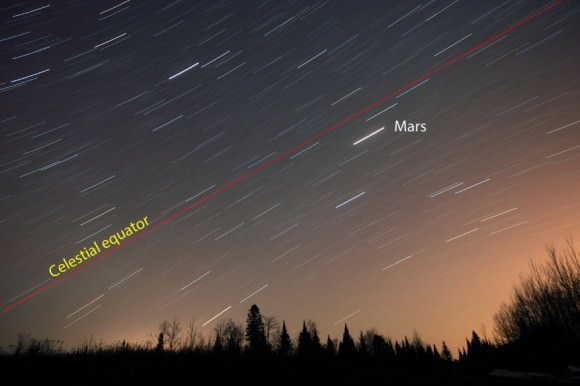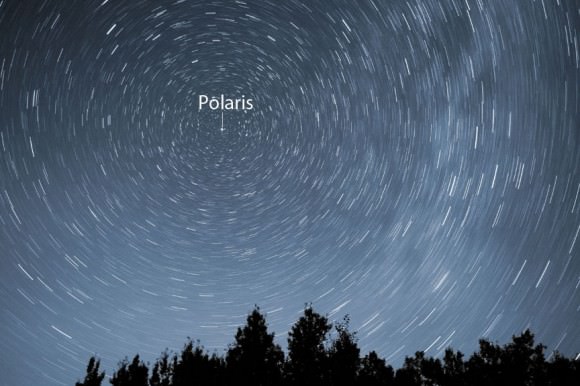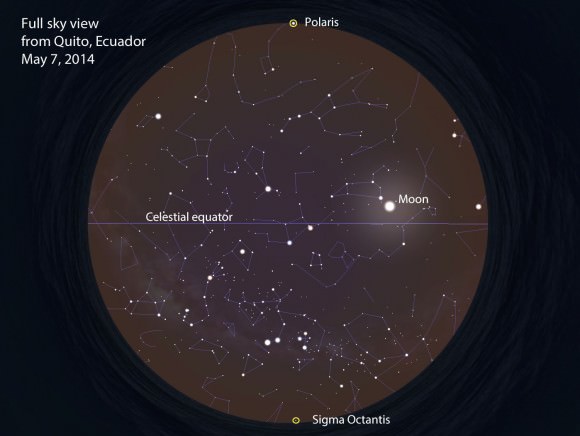A week ago I made a 45-minute time exposure of the southern sky featuring the planet Mars. As the Earth rotated on its axis, the stars trailed across the sky. But take a closer look at the photo and you’ll see something interesting going on.
The trails across the diagonal (upper right to lower left) are straight, those in the top third arc upward or north while those in the bottom third curve downward or south.

I suspect you know what’s happening here. Mars happens to lie near the celestial equator, an extension of Earth’s equator into the sky. The celestial equator traces a great circle around the celestial sphere much as the equator completely encircles the Earth.
On Earth, cities north of the equator are located in the northern hemisphere, south of the equator in the southern hemisphere. The same is true of the stars. Depending on their location with respect to the celestial equator they belong either to the northern or southern halves of the sky.

Next, let’s take a look at Earth’s axis and where each end points. If you live in the northern hemisphere, you know that the axis points north to the North Star or Polaris. As the Earth spins, Polaris appears fixed in the north while all the stars in the northern half of the sky describe a circle around it every 24 hours (one Earth spin). The closer a star is to Polaris, the tighter the circle it describes.

Likewise, from the southern hemisphere, all the southern stars circle about the south pole star, an obscure star named Sigma in the constellation of Octans, a type of navigational instrument. Again, as with Polaris, the closer a star lies to Sigma Octantis, the smaller its circle.

But what about stars on or near the celestial equator? These gems are the maximum distance of 90 degrees from either pole star just as Earth’s equator is 90 degrees from the north and south poles. They “tread the line” between both hemispheres and make circles so wide they appear not as arcs – as the other stars do in the photo – but as straight lines. And that’s why stars appear to be heading in three separate directions in the photograph.

In so many ways, we see aspects of our own planet in the stars above.


Hi Bob,
Nice article, it is something I have been teaching for years. Most students only image Polaris and circumpolar stars, they do not appreciate the other aspects that your feature draws out. What is also true is that the star trails in the night sky are a reflection of the shadows produced from a Shadow Stick during the daytime. I am based at 50 degrees North in the UK.
Brian Sheen – Roseland Observatory
I find the title of the article confusing. What has the title to do with the article text? What are the “polestars” (plural), why are they “hidden”, and which of those photo does “hint” at them (and how)? As is, this is probably he worst title I have seen here so far…
Astrophotographer Stephane Guisard has a remarkable image of star trails taken from equatorial Ecuador (matching your Stellarium view) that nicely illustrates some of the concepts brought up in this excellent article Bob: http://sguisard.astrosurf.com/Pagim/From_pole_to_pole.html
Tony the answer to your questions are;- The polestars are Polaris and sigma octans north and south pole respectively. The pole stars themselves are not in the first two images so the poles are “hidden”.
The problem with any short feature (in the original email) is to give it a title that makes the reader click on it to read the rest of the article on the webpage. It worked for me ….!